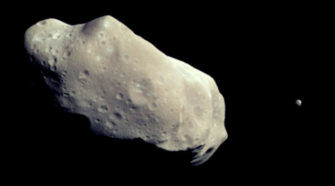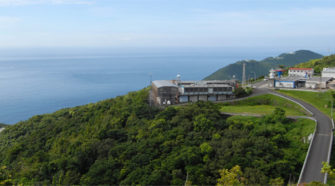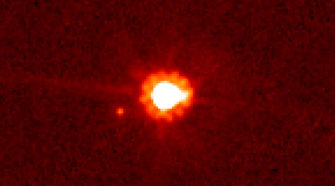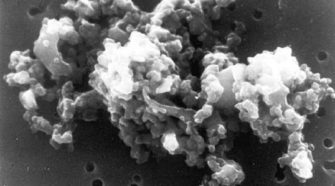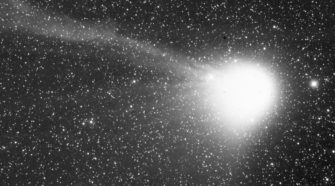Ice and Stone
Comet of the Week: 2I/Borisov I/2019 Q4
Perihelion: 2019 August 8.55, q = 2.007 AU According to our present understanding of how the solar system formed and evolved, all the various comets, including those passing through the inner solar system as well as those in the Kuiper Belt and the Oort Cloud, are the “leftovers” from the planet formation process. Over the …
Special Topic: “Small Bodies” Moons
The “Special Topics” presentation four weeks ago was on the subject of the small moons of the various planets in the solar system. It would seem reasonable to think that the bodies that possess moons don’t stop with the major planets, but that many of the “small bodies” that are the focus of “Ice and …
This Week in History: August 30-September 5
AUGUST 30, 1979: The SOLWIND coronagraph aboard the U.S. Defense Department’s P78-1 satellite records images of a bright comet approaching the sun, and then disintegrating. This comet, the first comet ever to be discovered from space, turned out to be a Kreutz sungrazer, and was the first of several comets discovered by SOLWIND prior to …
Comet of the Week: SOLWIND 1 1979 XI
Perihelion: 1979 August 30.95, q = 0.005 AU The very first comet I ever observed, Comet Tago-Sato-Kosaka 1969g – a previous “Comet of the Week” – was also the first comet ever to be observed from space, an event which took place in mid-January 1970. Since that time many, many comets have been observed by …
Special Topic: The Kuiper Belt
Where the various comets that we see in our skies come from has long been a subject of high scientific interest. The Week 3 “Special Topics” presentation discussed how in the mid-20th Century the Dutch astronomer Jan Oort proposed the existence of the structure that we now call the “Oort Cloud” as being the source …
This Week in History: August 23-29
AUGUST 23, 1862: The comet now known as Comet 109P/Swift-Tuttle passes through perihelion at a heliocentric distance of 0.963 AU. The comet had been discovered the previous month independently by Lewis Swift and Horace Tuttle, and became a conspicuous naked-eye object. It is the parent comet of the Perseid meteor shower and is a future …
Comet of the Week: Messier C/1769 P1
Perihelion: 1769 October 8.12, q = 0.123 AU As discussed in the “Special Topics” presentation on that object, in the early 18th Century the British astronomer Edmond Halley predicted that the comet that now bears his name would be returning around 1758. As that time approached several astronomers became involved in the effort to search …
Special Topic: Interplanetary Dust
The “Special Topics” presentation two weeks ago pointed out that the term “small bodies” of the solar system generally refers to objects like comets and asteroids, although that particular presentation discussed another class of such objects, i.e., the small moons of the planets. To carry the term “small bodies” to an extreme, we could examine …
This Week in History: August 16-22
AUGUST 16, 1898: DeLisle Stewart at Harvard College Observatory’s Boyden Station in Arequipa, Peru, takes photographs on which Saturn’s outer moon Phoebe is discovered, although the images of Phoebe were not noticed until the following March by William Pickering. Phoebe was the first planetary moon to be discovered via photography, and it and other small …
Comet of the Week: Levy 1990c
Perihelion: 1990 October 24.68, q = 0.939 AU I’ve commented in previous “Ice and Stone 2020” presentations that I spent several hundred hours unsuccessfully hunting for new comets before giving up that endeavor, and then accidentally discovered the comet that bears my name three years later. I did the bulk of my hunting during the …


